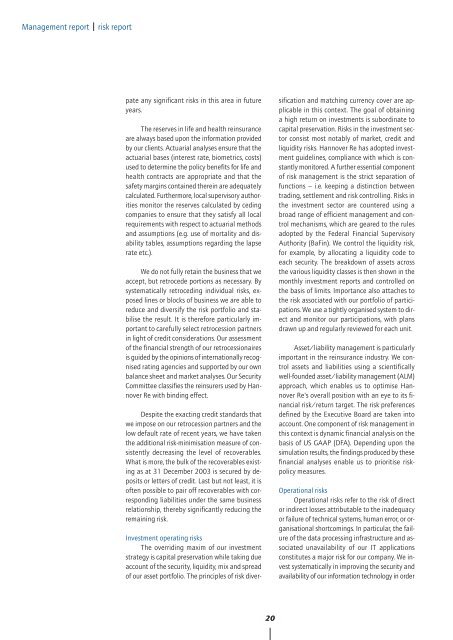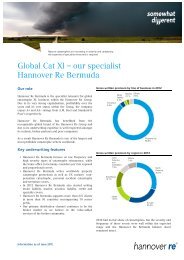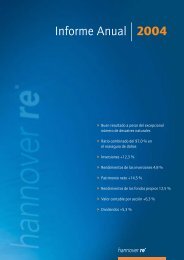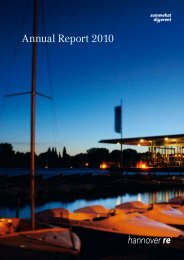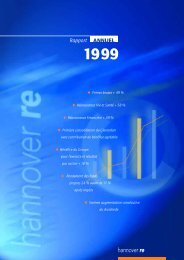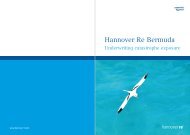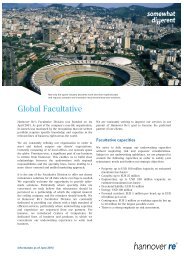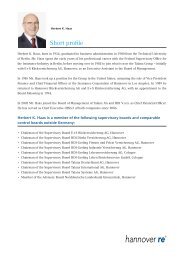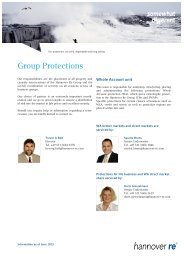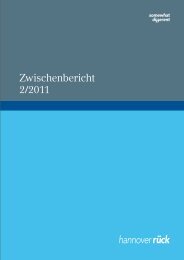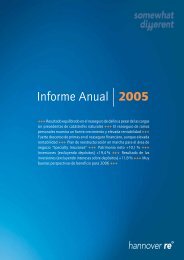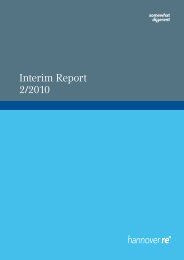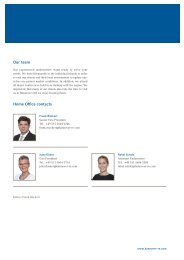Annual Report 2003 - Hannover Re
Annual Report 2003 - Hannover Re
Annual Report 2003 - Hannover Re
Create successful ePaper yourself
Turn your PDF publications into a flip-book with our unique Google optimized e-Paper software.
Management report<br />
risk report<br />
pate any significant risks in this area in future<br />
years.<br />
The reserves in life and health reinsurance<br />
are always based upon the information provided<br />
by our clients. Actuarial analyses ensure that the<br />
actuarial bases (interest rate, biometrics, costs)<br />
used to determine the policy benefits for life and<br />
health contracts are appropriate and that the<br />
safety margins contained therein are adequately<br />
calculated. Furthermore, local supervisory authorities<br />
monitor the reserves calculated by ceding<br />
companies to ensure that they satisfy all local<br />
requirements with respect to actuarial methods<br />
and assumptions (e.g. use of mortality and disability<br />
tables, assumptions regarding the lapse<br />
rate etc.).<br />
We do not fully retain the business that we<br />
accept, but retrocede portions as necessary. By<br />
systematically retroceding individual risks, exposed<br />
lines or blocks of business we are able to<br />
reduce and diversify the risk portfolio and stabilise<br />
the result. It is therefore particularly important<br />
to carefully select retrocession partners<br />
in light of credit considerations. Our assessment<br />
of the financial strength of our retrocessionaires<br />
is guided by the opinions of internationally recognised<br />
rating agencies and supported by our own<br />
balance sheet and market analyses. Our Security<br />
Committee classifies the reinsurers used by <strong>Hannover</strong><br />
<strong>Re</strong> with binding effect.<br />
Despite the exacting credit standards that<br />
we impose on our retrocession partners and the<br />
low default rate of recent years, we have taken<br />
the additional risk-minimisation measure of consistently<br />
decreasing the level of recoverables.<br />
What is more, the bulk of the recoverables existing<br />
as at 31 December <strong>2003</strong> is secured by deposits<br />
or letters of credit. Last but not least, it is<br />
often possible to pair off recoverables with corresponding<br />
liabilities under the same business<br />
relationship, thereby significantly reducing the<br />
remaining risk.<br />
Investment operating risks<br />
The overriding maxim of our investment<br />
strategy is capital preservation while taking due<br />
account of the security, liquidity, mix and spread<br />
of our asset portfolio. The principles of risk diversification<br />
and matching currency cover are applicable<br />
in this context. The goal of obtaining<br />
a high return on investments is subordinate to<br />
capital preservation. Risks in the investment sector<br />
consist most notably of market, credit and<br />
liquidity risks. <strong>Hannover</strong> <strong>Re</strong> has adopted investment<br />
guidelines, compliance with which is constantly<br />
monitored. A further essential component<br />
of risk management is the strict separation of<br />
functions – i.e. keeping a distinction between<br />
trading, settlement and risk controlling. Risks in<br />
the investment sector are countered using a<br />
broad range of efficient management and control<br />
mechanisms, which are geared to the rules<br />
adopted by the Federal Financial Supervisory<br />
Authority (BaFin). We control the liquidity risk,<br />
for example, by allocating a liquidity code to<br />
each security. The breakdown of assets across<br />
the various liquidity classes is then shown in the<br />
monthly investment reports and controlled on<br />
the basis of limits. Importance also attaches to<br />
the risk associated with our portfolio of participations.<br />
We use a tightly organised system to direct<br />
and monitor our participations, with plans<br />
drawn up and regularly reviewed for each unit.<br />
Asset/liability management is particularly<br />
important in the reinsurance industry. We control<br />
assets and liabilities using a scientifically<br />
well-founded asset/liability management (ALM)<br />
approach, which enables us to optimise <strong>Hannover</strong><br />
<strong>Re</strong>'s overall position with an eye to its financial<br />
risk/return target. The risk preferences<br />
defined by the Executive Board are taken into<br />
account. One component of risk management in<br />
this context is dynamic financial analysis on the<br />
basis of US GAAP (DFA). Depending upon the<br />
simulation results, the findings produced by these<br />
financial analyses enable us to prioritise riskpolicy<br />
measures.<br />
Operational risks<br />
Operational risks refer to the risk of direct<br />
or indirect losses attributable to the inadequacy<br />
or failure of technical systems, human error, or organisational<br />
shortcomings. In particular, the failure<br />
of the data processing infrastructure and associated<br />
unavailability of our IT applications<br />
constitutes a major risk for our company. We invest<br />
systematically in improving the security and<br />
availability of our information technology in order<br />
20


